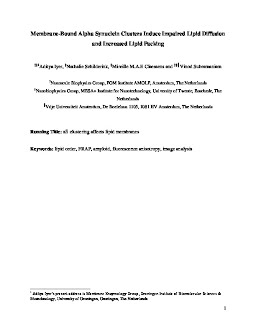2016-12-06
Membrane-Bound Alpha Synuclein Clusters Induce Impaired Lipid Diffusion and Increased Lipid Packing
Publication
Publication
Biophys. J. , Volume 111 - Issue 11 p. 2440- 2449
The aggregation of membrane-bound α-synuclein (αS) into oligomers and/or amyloid fibrils has been suggested to cause membrane damage in in vitro model phospholipid membrane systems and in vivo. In this study, we investigate how αS interactions that precede the formation of well-defined aggregates influence physical membrane properties. Using three truncated variants of αS with different aggregation propensities and comparable phospholipid membrane binding affinities we show, using fluorescence recovery after photobleaching (FRAP) and fluorescence anisotropy measurements, that formation of αS clusters on supported lipid bilayers (SLBs) impairs lateral lipid diffusion and increases lipid packing beneath the αS clusters. Formation of protein clusters starts immediately after monomer addition. The magnitudes of the changes in effective lipid diffusion and lipid order increase with the protein cluster size. Our results show that the combination of inter-αS and αS-membrane interactions can drive the formation of more ordered lipid domains. Considering the functional involvement of membrane micro-domains in biological membranes, αS-induced domain formation may be relevant for alternative disease mechanisms.
| Additional Metadata | |
|---|---|
| Elsevier/ Cell Press | |
| doi.org/10.1016/j.bpj.2016.10.016 | |
| Biophys. J. | |
|
Iyer, A., Schilderink, N., Claessens, M., & Subramaniam, V. (2016). Membrane-Bound Alpha Synuclein Clusters Induce Impaired Lipid Diffusion and Increased Lipid Packing. Biophys. J., 111(11), 2440–2449. doi:10.1016/j.bpj.2016.10.016 |
|
